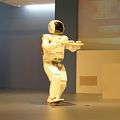Legged robots can have a unique role in manipulating objects in dynamic, human-centric, or otherwise inaccessible environments. Although most legged robotics research to date typically focuses on traversing these challenging environments, many legged platform demonstrations have also included "moving an object" as a way of doing tangible work. Legged robots can be designed to manipulate a particular type of object (e.g., a cardboard box, a soccer ball, or a larger piece of furniture), by themselves or collaboratively. The objective of this review is to collect and learn from these examples, to both organize the work done so far in the community and highlight interesting open avenues for future work. This review categorizes existing works into four main manipulation methods: object interactions without grasping, manipulation with walking legs, dedicated non-locomotive arms, and legged teams. Each method has different design and autonomy features, which are illustrated by available examples in the literature. Based on a few simplifying assumptions, we further provide quantitative comparisons for the range of possible relative sizes of the manipulated object with respect to the robot. Taken together, these examples suggest new directions for research in legged robot manipulation, such as multifunctional limbs, terrain modeling, or learning-based control, to support a number of new deployments in challenging indoor/outdoor scenarios in warehouses/construction sites, preserved natural areas, and especially for home robotics.
翻译:机器人的运动学习可以帮助它们在动态、以人为中心或其他无法到达的环境中操作物体。虽然到目前为止,大多数的机器人运动学习研究都集中在在这些具有挑战性的环境中穿行,但也有许多机器人平台展示了"移动物体"作为做有形的工作的一种方法。机器人的运动学习可以设计成单独或协作的方式来操作某种特定类型的物体(例如纸箱、足球或较大的家具)。本综述的目的是收集和学习这些例子,以整理社区中迄今为止所做的工作并突出未来工作的有趣开放方向。本综述将现有的工作分为四种主要的操纵方法:非抓握物体交互、步行腿操纵、专用的非运动臂和机器人队。每种方法具有不同的设计和自主特性,这些特性通过文献中的可用示例来说明。基于一些简化的假设,我们进一步提供了关于相对于机器人的操纵对象的可能范围的定量比较。这些例子一起表明,机器人操纵物体的新研究方向,如多功能肢体、地形建模或基于学习的控制,将支持具有挑战性的室内/室外场所的许多新部署,如仓库/建筑工地、保护的自然区域,特别是家庭机器人。


